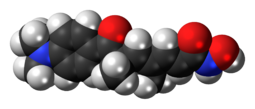Trichostatin A (TSA) is an organic compound that serves as an antifungal antibiotic and selectively inhibits the class I and II mammalian histone deacetylase (HDAC) families of enzymes, but not class III HDACs (i.e., sirtuins).[1] However, there are recent reports of the interactions of this molecule with Sirt 6 protein.[2] TSA inhibits the eukaryotic cell cycle during the beginning of the growth stage. TSA can be used to alter gene expression by interfering with the removal of acetyl groups from histones (histone deacetylases, HDAC) and therefore altering the ability of DNA transcription factors to access the DNA molecules inside chromatin. It is a member of a larger class of histone deacetylase inhibitors (HDIs or HDACIs) that have a broad spectrum of epigenetic activities. Thus, TSA has some potential as an anti-cancer drug.[3] One suggested mechanism is that TSA promotes the expression of apoptosis-related genes, leading to cancerous cells surviving at lower rates, thus slowing the progression of cancer.[4] Other mechanisms may include the activity of HDIs to induce cell differentiation, thus acting to "mature" some of the de-differentiated cells found in tumors. HDIs have multiple effects on non-histone effector molecules, so the anti-cancer mechanisms are truly not understood at this time.[5][6]
 | |
 | |
| Clinical data | |
|---|---|
| Pregnancy category |
|
| ATC code |
|
| Identifiers | |
| |
| CAS Number | |
| PubChem CID | |
| IUPHAR/BPS | |
| DrugBank | |
| ChemSpider | |
| UNII | |
| ChEBI | |
| ChEMBL | |
| CompTox Dashboard (EPA) | |
| ECHA InfoCard | 100.107.856 |
| Chemical and physical data | |
| Formula | C17H22N2O3 |
| Molar mass | 302.374 g·mol−1 |
| 3D model (JSmol) | |
| |
| |
| | |
TSA inhibits HDACs 1, 3, 4, 6 and 10 with IC50 values around 20 nM.[7]
TSA represses IL (interleukin)-1β/LPS (lipopolysaccharide)/IFNγ (interferon γ)-induced nitric oxide synthase 2 (NOS2) expression in murine macrophage-like cells but increases LPS-stimulated NOS2 expression in murine N9 and primary rat microglial cells.[8]
Vorinostat is structurally related to trichostatin A and used to treat cutaneous T cell lymphoma.[9]
See also
editReferences
edit- ^ Vanhaecke T, Papeleu P, Elaut G, Rogiers V (June 2004). "Trichostatin A-like hydroxamate histone deacetylase inhibitors as therapeutic agents: toxicological point of view". Current Medicinal Chemistry. 11 (12): 1629–1643. doi:10.2174/0929867043365099. PMID 15180568.
- ^ You W, Steegborn C (December 2018). "Structural Basis of Sirtuin 6 Inhibition by the Hydroxamate Trichostatin A: Implications for Protein Deacylase Drug Development". Journal of Medicinal Chemistry. 61 (23): 10922–10928. doi:10.1021/acs.jmedchem.8b01455. PMID 30395713.
- ^ Drummond DC, Noble CO, Kirpotin DB, Guo Z, Scott GK, Benz CC (2005). "Clinical development of histone deacetylase inhibitors as anticancer agents". Annual Review of Pharmacology and Toxicology. 45: 495–528. doi:10.1146/annurev.pharmtox.45.120403.095825. PMID 15822187.
- ^ Shankar S, Srivastava RK (2008). "Histone Deacetylase Inhibitors: Mechanisms and Clinical Significance in Cancer: HDAC Inhibitor-Induced Apoptosis". Programmed Cell Death in Cancer Progression and Therapy. Advances in Experimental Medicine and Biology. Vol. 615. pp. 261–98. doi:10.1007/978-1-4020-6554-5_13. ISBN 978-1-4020-6553-8. PMID 18437899.
- ^ Joanna F, van Grunsven LA, Mathieu V, Sarah S, Sarah D, Karin V, et al. (September 2009). "Histone deacetylase inhibition and the regulation of cell growth with particular reference to liver pathobiology". Journal of Cellular and Molecular Medicine. 13 (9B): 2990–3005. doi:10.1111/j.1582-4934.2009.00831.x. PMC 4516460. PMID 19583816.
- ^ Movafagh S, Munson A (January 2019). "Chapter 4 - Histone Deacetylase Inhibitors in Cancer Prevention and Therapy". In Bishayee A, Bhatia D (eds.). Epigenetics of Cancer Prevention. Translational Epigenetics. Vol. 8. Academic Press. pp. 75–105. doi:10.1016/b978-0-12-812494-9.00004-4. ISBN 978-0-12-812494-9.
- ^ US 8232297, Maier T, Beckers T, Hummel RP, Feth M, Muller M, Bar T, Volz J, "Novel Sulphonylpyrroles as Inhibitors of Hdac S Novel Sulphonylpyrroles", issued 31 July 2012, assigned to 4SC AG
- ^ Adcock IM (April 2007). "HDAC inhibitors as anti-inflammatory agents". British Journal of Pharmacology. 150 (7): 829–831. doi:10.1038/sj.bjp.0707166. PMC 2013887. PMID 17325655.
- ^ Bubna AK (2015). "Vorinostat-An Overview". Indian Journal of Dermatology. 60 (4): 419. doi:10.4103/0019-5154.160511. PMC 4533557. PMID 26288427.
Further reading
edit- Moon C, Kim SH, Park KS, Choi BK, Lee HS, Park JB, et al. (June 2009). "Use of epigenetic modification to induce FOXP3 expression in naïve T cells". Transplantation Proceedings. 41 (5): 1848–1854. doi:10.1016/j.transproceed.2009.02.101. PMID 19545742.